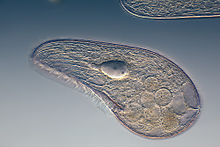Blepharisma
| Blepharisma | |
|---|---|
 |
|
| Blepharisma japonicum | |
| Scientific classification | |
| Domain: | Eukaryota |
| (unranked): | SAR |
| (unranked): | Alveolata |
| Phylum: | Ciliophora |
| Class: | Heterotrichea |
| Order: | Heterotrichida |
| Family: | Blepharismidae |
| Genus: |
Blepharisma Perty, 1852 |
Blepharisma is a genus of unicellular ciliate protists found in fresh and salt water. The group includes about 40 accepted species, and many sub-varieties and strains. While species vary considerably in size and shape, most are easily identified by their red or pinkish color, which is caused by granules of the pigment blepharismin.
All members of the genus possess a long series of membranelles on the left side of the oral groove, and an "undulating membrane" (a structure resembling a flap, scarf or small sail, composed of long cilia fused together as a single sheet) on the right side of the peristome, toward the posterior.
Certain species of Blepharisma have served as model organisms for scientific research. Since some varieties are easily cultured and readily available from scientific supply houses, they are a common object of study in school science classes.
Blepharisma may be as small as 50 micrometres in length, or as large as 1 mm (though normal size range is between 75 and 300 micrometres). Body shape varies within the genus. The type species of the genus, B. persicinum, is ellipsoidal. Blepharisma lateritium is teardrop-shaped, with a rounded posterior; while Blepharisma elongatum and Blepharisma sphagni are long and thin, tapering at the posterior into a tail-like point.
All species are uniformly ciliated, with the cilia arranged in longitudinal rows, and stripes of pigment alternating between rows of cilia. Cilia, short hairlike organelles, sweep food into its mouth and are used for movement. The pink or red pigmentation may be quite pale, and in certain cases it is absent altogether. A contractile vacuole, often quite large, is located in the posterior. The Macronuclei can take a variety of forms. Depending on species and phase of life, they may be rod-shaped, ovoid, spherical, or moniliform (like a rosary, or string of beads).
Like all ciliates, Blepharisma reproduce asexually, by binary fission, dividing transversally. Fission may occur spontaneously, as part of the vegetative cell cycle, or it may follow a sexual phenomenon called conjugation, a process through which genetic material is exchanged between cells. In conjugation, two organisms come into close contact, and a temporary cytoplasmic bridge forms between them. The micronuclei of each cell then undergo meiosis, and haploid micronuclei pass from one individual to the other. This permits the reshuffling of hereditary characteristics, as in other types of sexual reproduction. Conjugation is immediately followed by binary fission of the two conjugants.
...
Wikipedia
